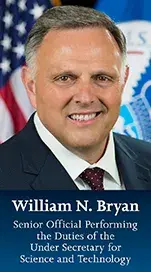November comes with colder temperatures, stretchy pants for turkey dinners with all the fixings, and the start of the busy holiday travel season. As you make your final packing checklists and prepare to visit with family and friends, I ask that you take a moment to learn more about how the men and women of the Department of Homeland Security (DHS) Science and Technology Directorate (S&T) work tirelessly to increase the security of our aviation industry.
 Earlier this month, S&T launched our latest S&T Impact Series case study that highlights the numerous detection, mitigation, and prevention efforts we are taking to strengthen our nation’s aviation security. This three-pronged approach helps all of us (and our belongings) get to our destinations safely and securely.
Earlier this month, S&T launched our latest S&T Impact Series case study that highlights the numerous detection, mitigation, and prevention efforts we are taking to strengthen our nation’s aviation security. This three-pronged approach helps all of us (and our belongings) get to our destinations safely and securely.
Detection
S&T works tirelessly through its research and development (R&D) efforts to leverage the brightest minds and power of technology to detect potential hazards before they become true threats. Whether it is through enhanced screening of luggage and air cargo, working with detection canines or hosting forums on the future of aviation security, a large part of our efforts include collaborating with other federal agencies, as well as state and local law enforcement.
When it comes to aviation security, working with the Transportation Security Administration (TSA) is key. Our TSA colleagues are on the front lines every day, protecting our travelers, crews, and baggage, but did you also know that every commercial passenger flight also transports air cargo? All the cargo needs to be screened to the same level as checked passenger baggage. S&T is collaborating with TSA to address the challenges associated with breaking down cargo skids to screen items. S&T has funded the development of the Opacity and Complexity Analysis Software Tool, a powerful image processing software, to support x-ray operators in determining possible threats in cargo.
Mitigation
To mitigate something is to lessen the severity. Part of S&T’s work is to assess technologies and provide training to better identify and mitigate potential threats. One of our programs, the Commercial Aircraft Vulnerability and Mitigation program, supports the testing and evaluation efforts to assess potential vulnerabilities and evaluate countermeasures that can diminish the impact of explosives on commercial aircraft. Every day millions of passengers flow through TSA security lines nationwide; if you have traveled via air before, chances are you may have received a pat-down while going through security. S&T worked with TSA to develop the Pat-down Accuracy Training Tool to ensure TSA officers receive the best training possible and to standardize the pat-down procedure for consistency and effectiveness. This is one example of how S&T aims not only to bolster, but also to streamline, processes for agents and civilians alike.
Prevention
Apart from just detecting threats or mitigating a potential attack, S&T works to prevent future attacks. We began studying and collecting data on homemade explosives (HMEs) after the 2005 London mass transit system attacks. The data is used by the HME Rapid Response Team to characterize explosive threats against transit systems, develop countermeasures, and strengthen our detection and response capabilities to prevent an attack. Part of preventing future attacks is looking at current security screening measures being used in airports and asking the question: how can we make airport security screenings better and more efficient? The Apex Screening at Speed program is looking to answer those questions. Whether it’s a shoe scanner that would allow travelers to keep their shoes on or an upgraded x-ray scanner for carry-on bags that would provide greater security without the need to remove restrictions like liquids and electronic devices, S&T is looking to R&D activities that advance the future of aviation security.
The aviation security case study is one piece of an overall strategy for ensuring our homeland remains strong and all who serve and inhabit it remain safe. As you pass through your local airports this holiday season, I hope you will take a moment to appreciate all of the advanced security measures and thank our TSA colleagues who help you on your way.
Have a safe, happy, healthy (and filling) Thanksgiving! If you need some travel reading, visit our website for more about S&T’s Explosives Detection and Aviation Screening mission, as well as the other case studies in the impact series that focus on border security, cybersecurity, critical incidents, and disaster response. Also, follow us on Twitter, Facebook, LinkedIn, Instagram, and YouTube for more S&T Impact Series updates!
